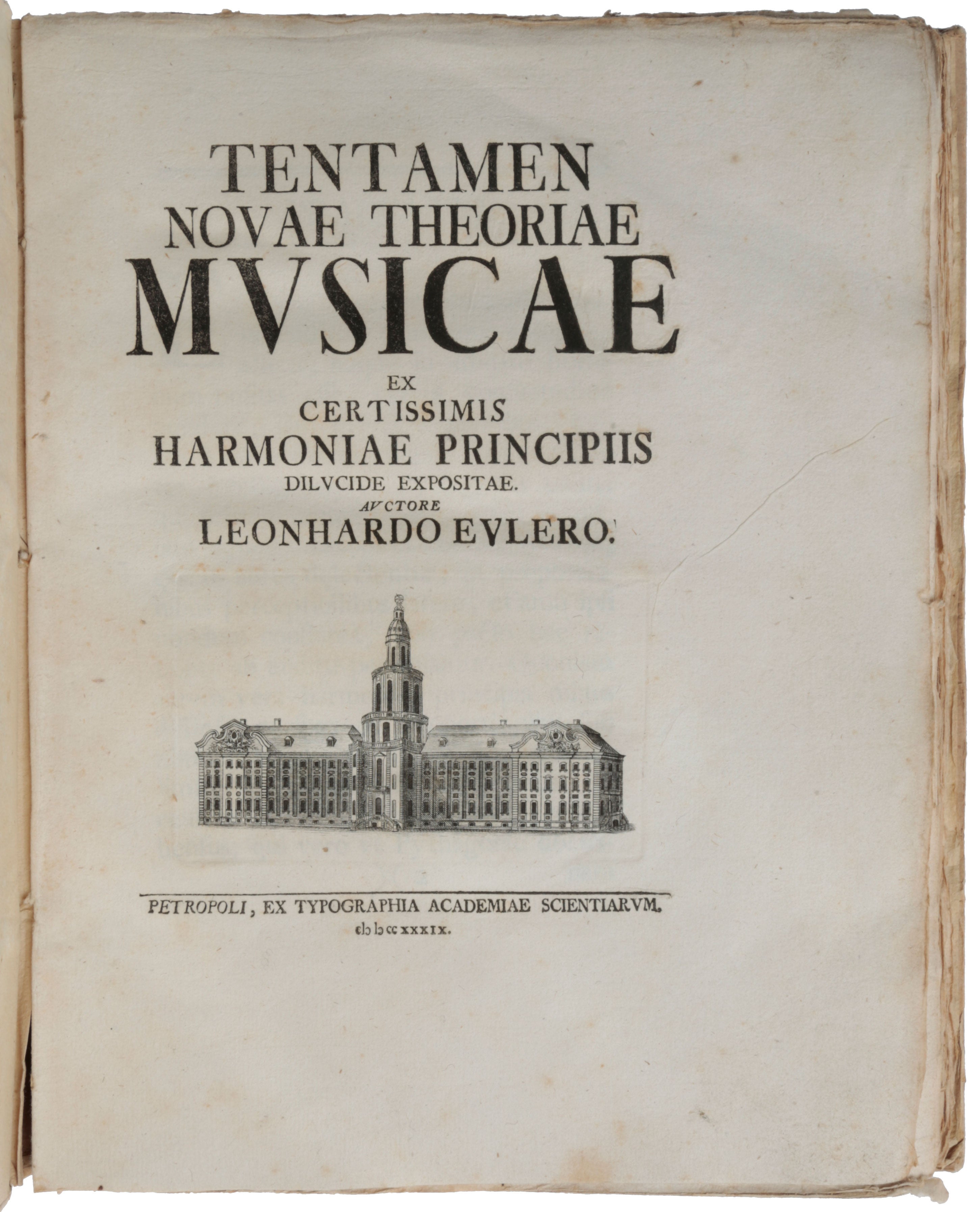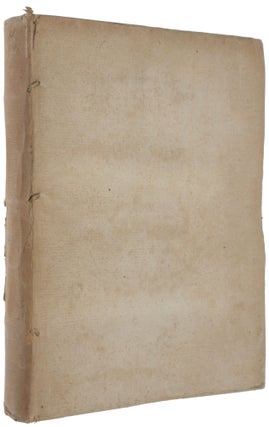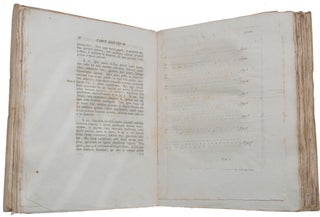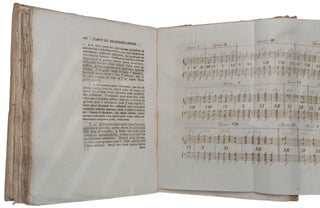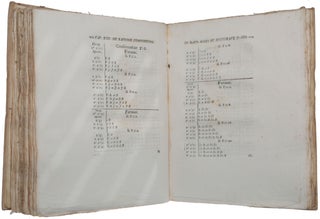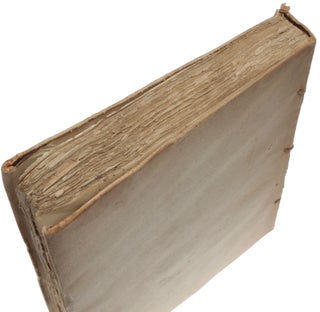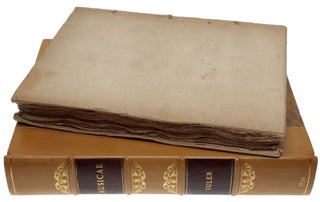Tentamen Novae Theoriae Musicae Ex Certissimis Harmoniae Principiis Dilucide Expositae.
St. Petersburg: ex Typographia Academiae Scientiarum, 1739. First edition, and a remarkable copy in original state, of Euler’s most important work on music. The Swiss mathematician, scientist and philosopher Leonhard Euler (1707-1783) “contributed more to theoretical acoustics as the subject is now known than has any other man” (The New Grove Dictionary of Music and Musicians). “Music had occupied Euler since his youth, as is shown by his notebooks from the time in Basel, and already in about mid-1731 he was able to deliver to the Academy of Petersburg – in a certain sense as a ‘mandatory assignment’ – a music-theoretical work, which according to the first proofs carried the title Tractatus de musica, but only eight years later appeared in print in Petersburg as a monograph under the title Tentamen novae theoriae musicae [Attempt at a new theory of music]. This work was later followed up by Euler with yet three other memoirs, mainly dedicated to the natural seventh. In the Tentamen, Euler treats not only the mathematical laws of consonance, but also aspects of the theory of composition. On the basis of old-Pythagorean principles of harmony, according to which the subjectively perceived degree of beauty of an interval depends on the simplicity of the frequency ratio, Euler – in the first attempt undoubtedly influenced by his predecessors Mersenne, Descartes, and Leibniz – operates with his number-theoretically motivated concept of degree of consonance. The fact that Euler’s deductive theory, contrary to Rameau, did not get accepted in its logical rigor can certainly not be blamed only on the equal temperament, spreading and accommodating certain practitioners already at that time, but rather on the fact that Euler’s tonal system was not even ‘well tempered’ in the sense, say, of Werckmeister, and did not sufficiently meet the needs of contemporary musical practice. Moreover, Euler’s Tentamen to musicians may well have appeared too mathematical, and to mathematicians too musical” (Fellmann, pp. 47-48). “According to Fuss’s eulogy of Euler, music was one of the few relaxations that Euler allowed himself. This suggests that he possibly played the clavier often and may have deepened his schema for music theory during moments of pleasure from the harmony that he achieved in playing compositions. Amid chords he likely calculated proportions. Harmony is central to most Western music, entailing a movement or progression among chords. The clavier was at this time becoming more complex; it had delicate tones and was intended for performance in a room. The larger harpsichord, with richer tones and meant for concert halls, Euler knew well and listened to, but no record exists of his playing it. His Basel notebook outlines a book on music theory. His correspondence with Johann I Bernoulli reveals that subject as also being an assignment from the academy. By May 1731 Euler had nearly completed a short treatise on music theory, its first proofs bearing the title Tractatus de musica. It was not possible, however, to publish a science monograph so early in his career. Following the Tractatus, he worked diligently to perfect his ideas by adding new insights and conclusions. The result was a more mature work, the 263-page Tentamen novae theoriae musicae ex certissimis harmoniae principiis dilucide exposita (An attempt at a new theory of music composition exposed in full clarity according to the most certain principles of harmony), which the press of the Petersburg Academy published in 1739 … “In the Tentamen Euler sought to provide a new music theory, one that was ‘part of mathematics and [would] deduce in an orderly manner ex certissimus harmonicae principiis [from the most certain principles of harmony] everything which can make pleasing a fitting together and mingling of tones.’ His music theory had a dual foundation: from the sciences came an exact knowledge of sound and from metaphysics came the method of how the relations of the frequency of vibrations in the air by harmony please—or by disharmony displease—auditory perceptions. To decide all this Euler appealed to reason, experience, and adept computations. The Tentamen demonstrates his pursuit of systematic order, his skillful crossing of disciplinary boundaries, and his search for deeper connections among fields—in this case acoustics, optics, and vibration theory. Vibratory motion, he concluded, was the cause of sounds and hearing, with sound transmitted by pulses in the air. “Chapter 1 of the Tentamen summarizes the principles and a structure of acoustics that expands upon Euler’s ‘De Sono.’ Section 9 presents his formula for a vibrating string’s frequency: 355/113 = √3166n/a, where n is the ratio of a string’s stretching weight to its normal weight and a gives the string’s length. The value 355/113 = 3.1415929 is accurate to six decimal places of π … “Essential to Euler’s notion of order in music theory was basing the tonal scale upon numerical ratios of frequency. By preferring to pursue mathematical computations rather than philosophical analysis for foundations, he separated himself from his contemporaries; no one had taken music theory as far mathematically as had Euler. Seventeenth-century music theorists had shown pitch to be proportional to frequency: musical intervals were frequency intervals, the inverse of length ratios. Euler thus rejected Aristoxenus, who wanted no numerical ratios in music theory. Euler found the work of the Pythagoreans and Aristoxenus to be filled with confusion and errors, and he warned that Pythagorean principles alone were insufficient and, when their limits were unrecognized, a potential source of errors. He carefully built upon Pythagorean and Ptolemaic laws, claiming an agreement between the ancients and his modern thought. “Toward scientific authority Euler displayed a critical, skeptical attitude that was sometimes playful. Vibrations are heard as tones, and in diatonic systems succeeding tones give the individual terms in the next octave. The ratio of frequencies of two sounds given in small integers from the simplest order of two notes in unison (1:1) proceeds through the fundamental chords or consonance of the octave, 2:1, to the fifth, 3:2, where one of the numbers is not 1, to the fourth, 4:3, and so forth. Euler saw these as blows upon the tympanum of the ear conveyed through the intermediary of the air. “One of Euler’s two supports for the metaphysical foundation for music in a text filled with mathematical formulas and notes is the degree of consonance or pleasantness among tones, his gradus theoria. He cautioned, however, that there were no clear borders between the notes C and D. He agreed with the ancients that the simpler the ratios of vibrations of the air the more consonant and pleasing the intervals would be. As had Ptolemy and Descartes, he calculated these tonal scales by intervals using the small prime numbers of the harmonic triad, consisting of the musical integers 2, 3, and 5, together with the ‘exponent of the Ptolemaic tonal system,’ 2n · 33 · 5 · N = 6 he called the exponent of accord, and he allowed for higher octaves with multiples and powers of these integers. From these Euler constructed a finite number of genera. He differed with his contemporaries in music, who employed only 3 and 5. Instead he gave 2 an essential role. He disagreed with them, for example, that the pitch 8 is a combination of 7 + 1 or 9 – 1. Rather, he maintained that it is 23, the third octave of basic vibration 1. So far he confirmed the findings of Leibniz, who held that the musical world had not yet learned to count beyond 5. Measuring lengths, weights, and tensions of two strings for a given musical note, Euler calculated their absolute frequencies or vibrations per second. But he provided no experimental confirmation of the frequencies. His computations draw upon analogic reasoning and include difficult logarithms and continued fractions. “Chapter 4 gives a first approximation of ratios in the progression from the octave to the fourth to the fifth. Multiplying two smaller semitones comes to .30103001/.1760903, or log 2/log 1.5. Euler expressed this as [a] continued fraction. Chapters 10 and 13 warn that attempts to introduce any number besides the triad (2, 3, and 5) are difficult and have produced numerous errors. “In book 1, sections 19, 28, and 32 of the Tentamen Euler mostly followed Ptolemy. To reach one or more octaves and arrange all consonances by degrees, he multiplied by a second power of consonance: 1; 3, 22; 5; 3 · 5; 32 · 5; 33 · 5; … Each octave of the diatonic-chromatic system of his time includes twelve tones. The octave for the first degree contains the relation of C:E:G:B, which makes a major seventh chord. Euler later computed it to be the proportion 36:45:54:64. The least common multiple or exponent of 8,640 is 26 · 33 · 5, which Euler named the exponent of accord. This puts related figures into the seventeenth degree of consonance. How high a sound could be, Euler discovered, depended upon the rapidity of tones, and he investigated limits of hearing. In the development of vibration theory and continuum mechanics, the measurement of audible vibrational frequencies to their upper and lower limits was critical. “A second essential support for the foundation of music theory, along with his gradus theoria, was Euler’s substitution theory concerning proper hearing as basic for explaining music. Section 20 of chapter 10 and section 19 of chapter 13 warn of the great difficulty for computing harmony in applying 7, the next prime number after the harmonic triad. Euler declared that attempts had produced numerous errors. He found it difficult to introduce 7, ‘since the consonances sound too hard.’ He asserted that 7 neither joined with 2 or 3 and added to 5 would produce pleasant sounds. For the moment, he did not clearly explain a dominant seventh chord on the tonal triad and treated it as purely a conjecture. But in the 1760s, and in a paper in 1773, he accepted it. The seventh leading note, 7:4, needed examination. Mersenne’s Harmonie universelle of 1636, which invoked 7 and employed analogies between music and other physical phenomena, probably influenced Euler, and Leibniz’s extension to 7 of the basics for music most certainly did. Euler’s drawings in the Tentamen and his later Lettres à une Princesse d’Allemagne (Letters to a German princess) are considered the origins of Venn diagrams in mathematics” (Calinger, pp. 152-8). Enestroem 33; RISM Ecrits, p. 298; Gregory & Bartlett, I, p.85; Hirsch, i 161. Calinger, Leonhard Euler, 2015. Fellmann, Leonhard Euler, 2006.
Large 4to (285 x 220 mm), pp. 21, [1], 263, [1, blank], engraved vignette of the St. Petersburg Academy of Sciences on title, 4 engraved folding plates and 2 folding printed tables. Uncut and unpressed in the original printer’s interim boards. Fine and clean throughout.
Item #5636
Price: $7,000.00

